COVER CROP CONFUSION
How Much Soil Organic Matter?
In last week’s blog I kept jumping the fence about cover crops. First I extolled their benefits. Then I wrote that they’re probably unnecessary in my heavily composted ground and possibly to blame for poor growth of some corn and tomatoes. Finally, I wound up stating that I do grow some cover crops anyway. No wonder I caused some confusion.
 All this prompted one reader, Peter, to comment with some specific questions that might also be of interest to some of you. I will now try to answer them.
All this prompted one reader, Peter, to comment with some specific questions that might also be of interest to some of you. I will now try to answer them.
His first question was: “How is percentage of organic matter in the soil determined.” “Organic matter” is carbon compounds; as such they can be oxidized, and when this happens they are lost from the soil as carbon dioxide and water. Microorganisms do this naturally in any soil as they feed on organic matter, in so doing releasing minerals associated with the organic matter in forms that plants can use for nourishment.
The way to test the percentage of organic matter in the soil is to weigh a sample, oxidize the organic matter, then weigh it again to measure the loss. Oxidation can be done by burning the sample at high temperature. Another way is to chemically oxidize a weighed sample using potassium dichromate and then measure how much dichromate is left after the reaction. (The latter reaction is more accurate than burning because carbonates in a soil will also lose carbon dioxide when heated, affecting the final weight.)
Peter, I suggest against determining the percentage organic matter of your soil in your kitchen. Soil labs generally include percentage organic matter along with other test results. (I cover soil testing in my book Weedless Gardening.)
Peter also reported that his soil tests very high in phosphorus, potassium, magnesium, and calcium. Soils to which have been added lots of organic matter typically test very high or excessive levels of phosphorus and potassium. That doesn’t present a problem, possibly because, as I wrote last week, “Conventional soil tests are for mineral soils, not soils that are very high in organic matter.”
As far as the high levels of calcium and magnesium, I’m not sure about that. Excessive applications of dolomitic limestone would cause that, and that would also be reflected in a high pH.
To Cover Crop or Not to Cover Crop, That is the Question
Now for a more difficult question. Why do I plant cover crops if I don’t think they’re of benefit in my soil? I guess that’s because I’m aware of the known benefits of cover crops. If nothing else, the cover crop obviously protects the ground’s surface from the pounding of raindrops and wide swings in temperature. Even if I don’t notice any positive impact, they may be there, more subtly. And then there are the still unknown benefits of cover crops.
 The major, consistent negative impact of my late summer of fall planted oat cover crops has been to increase the number of weeds the following spring, specifically henbit (Lamium amplexicaule). For the past couple of years I’ve dealt with that problem by tarping those beds in spring for a couple of weeks or more. Or, not as good, just pulling out the henbit.
The major, consistent negative impact of my late summer of fall planted oat cover crops has been to increase the number of weeds the following spring, specifically henbit (Lamium amplexicaule). For the past couple of years I’ve dealt with that problem by tarping those beds in spring for a couple of weeks or more. Or, not as good, just pulling out the henbit.
Because I only cover crop beds that are no longer needed for vegetable plants towards the end of the growing season, growing the cover crops doesn’t take up space in which I could otherwise grow vegetables.
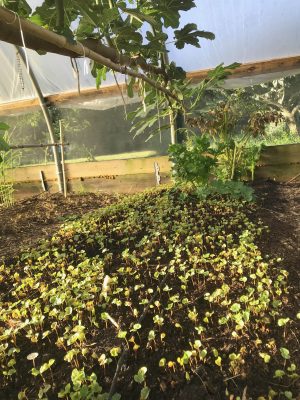
Buckwheat cover crop in greenhouse
It’s also almost no trouble to sprinkle the oat seed over the bed before laying down the inch of compost each bed gets every year.
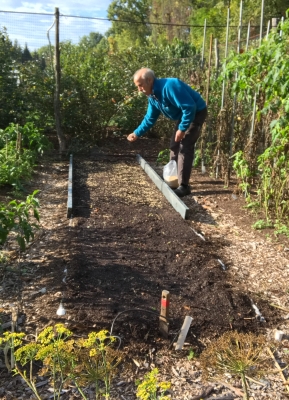
And finally, I have to admit that I like the lush green look of the oat leaves, the leaves maintaining that look almost until the first day of winter. And even after that, they flop down on the ground, dying, but then hiding the brown compost beneath a tawny blanket.
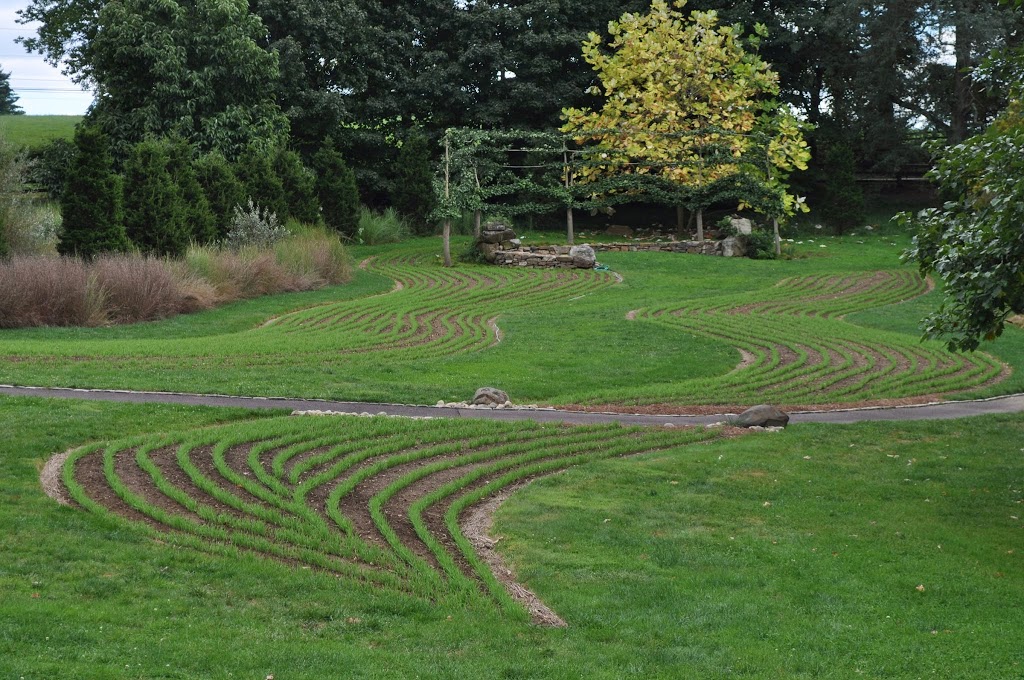
Rye cover crop at Chanticleer Garden
Timely Planting
Last question: “When is the latest time to plant the cover crop?” Cooler weather and diminishing sunlight dramatically slow plant growth in autumn. Oats like that cool weather, and will germinate and sprout pretty late in the season. But there comes a time when so little growth will ensue that oats or any other cover crop is not really worth planting.
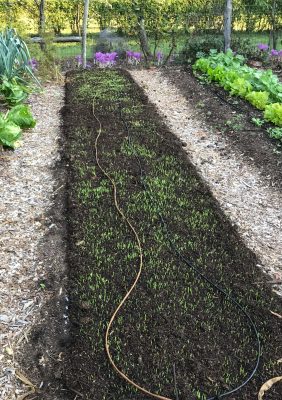
Here, about half way up New York’s Hudson Valley (USDA Hardiness Zone 5), I figure on the latest date to make planting a cover crop worthwhile is about October 1st.
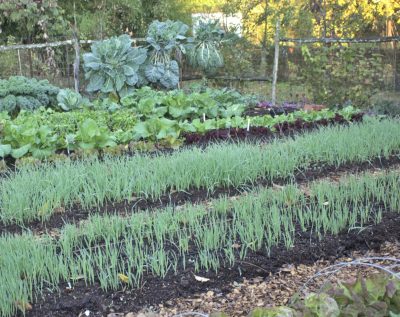


Lee,
Thank you for the detailed answers. I definitively won’t try to practice chemical lab in my kitchen sink, but is it worthwhile/safe to deal with potassium dichromate at home? What proportion of it vs. the sample size should be? My soil test result from the Rutgers, part of which I shared with you, doesn’t mention anything about the organic matter.
That’s odd that the soil test doesn’t mention organic matter. How about “SOM” (soil organic matter)? I just looked up a test I had done by Penn State in 2008, and no mention of organic matter. A Cornell test in 2018 does list it. If you really want to know, I suggest finding a lab that does test SOM. For the dichromate test, you have to determine the amount dichromate (Cr2O7) ion remaining after reaction with the soil sample is quantified by titration with FeSO4.
lea,
I just realized that Rutgers does SOM as well but for additional $33. It is listed as an option for: “Additional agronomic properties soluble salt level, organic matter content, % sand/silt/clay, textural class and gravel content”. I will do it next season.
Thank you for education. 🙂
You could also dod it now. That information is worth the $33.
Hi Lee!
We used untreated straw from a farm to mulch our berry patch, then went away for a few weeks of heavy rain — and returned to a small wheat field! This was fine, though, as it pulled out easily, it had worked well against weeds, and the berries were fine.
In the meantime, we have been trying to build a small meadow. We let our lawn grass grow, but it just flopped over — not very picturesque — so we’ve now mowed the whole thing down.
We thought of planting the meadow with oats, but now I see that yours flop too.
Suppose we just got a couple more straw bales from that same farm, threw them on the meadow, kept it wet, and hoped for a wheat field to pop up there instead?
Can you see any reason that would not work? The wheat looked beautiful, and would — I imagine — remain standing in a picturesque manner.
Also, we are tired and nearly gardened-out for the year.
Best wishes,
S.S.
Western Massachusetts
I suggest just letting the grass grow for a few seasons, mowing it once a year in late fall or early spring. Over time, meadow plants will invade it, each year adding to its character. A meadow isn’t static; it changes over time depending on when it’s mown, the weather, the soil, and many other factors. Annual or biannual mowing is needed to slow invasion by woody plants which start the change from meadow to forest inn this part of the world.
Thank you!!
Hi Lee, we have high Mg (borderline toxic, according to standard soil reports) due to our old seabed serpentine-based soil. Makes me crazy all the local ads to use Epsom salts for increased vegetable yields and then I get called out to diagnose what is usually Mg toxicity….
I suppose you also know about the danger (asbestos) from breathing dust from that soil.
Hi Lee,
Very informative posts on cover crops!
Can I ask why summer or fall planted oat cover crops increase weeds the following spring? Is it because it is allelopathic so germination gets deferred? Or the winter killed oats provide a convenient mulch for the weeds to easily germinate in the spring? Or something specific about henbit?
Thanks!
I actually don’t know why there was an increase in weeds, and for most people this may not, is probably not, the case. My guess is that certain weeds that tolerate the shade and environment beneath the oats get a foothold.